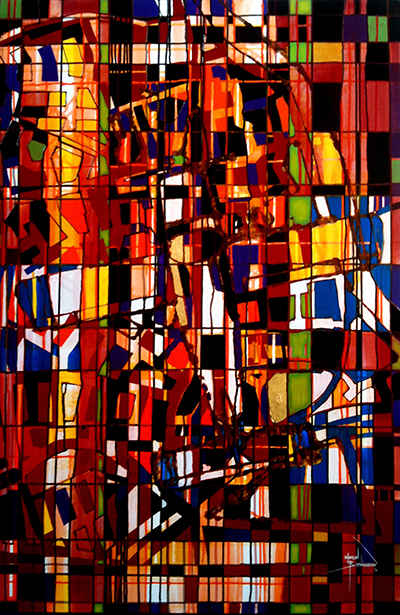By Jill Smith
Marcel Bastiaans started painting when he was eight years old. Realizing that he was different at a young age, he took his childish spontaneity and uncontrolled emotion into his future career. His artworks are positive, joyful, based on dreams, on freedom. The recurrent image of a bird symbolizes that freedom. He is willful; he paints what he wants to paint, and the way he wants to paint it. Each work is a copy of the original in his mind; a combination of emotion, realism, and abstraction. There is a recognizable element, de-contextualized, and integrated into a new, graphical environment, entirely based on the artist’s impression and preference.
He uses acrylic and oil paint, gold leaf and shell, and applies several thin layers on the canvas. Colors contrast with each other, and therefore at the same time, they are in balance. You can see the stratification in each work: firm lines are intersecting; they create a grid; a pattern of squares, now and then confidently filled with a color that covers certain parts of a realistic subject. Those unusual colors prove that Bastiaans sees reality as an illusion, it can be changed.
A warm yellow, almost like honey, is the central color in Great Tit, supported by purple, sky-blue, white, and black squares. The black, brown, and orange lines – some of them are parallel, others are not–almost seem to create a birdcage, but they do not enclose the image of the bird. The fragile bird is combined with brutally shaped rectangles, dominating the painting, until the subject disappears and the environment becomes the center of the attention. By using similar colors, and larger open areas, there is a lot of breathing space in this work. The bird looks into the direction of that open space, its beak resting upon one of the horizontal lines. It is a captivating piece.
In Energy! the fresh green and purple are balanced. Nevertheless, you can sense a kind of creative madness. Black, white and red squares catch the eye, covering specific areas of Albert Einstein’s face, like patches. Einstein, of course, be- ing one of the preeminent thinkers of the 20th century, is depicted in a very playful manner. After all, he did state, “Imagination is more important than knowledge.”
For knowledge is limited to all we now know and understand, while imagination embraces the entire world, and all there ever will be to know and understand.” Even when he is not using the characteristic maze in his artworks, Bastiaans is still referring to squares and rectangles. Sometimes he uses them to build an idea of a city, as a background for a robin. Sometimes he just uses vertical lines, to indicate a direction. The results are forceful directional lines that capture great movement. I recently interviewed Bastiaans to find out more about his wonderful work.

Courtesy of the artist.
Jill Smith: Your starting point seems to be reality, which you de-contextualize by using unusual colors or an abstract frame- work. Is that approach based on your impression of that reality?
Marcel Bastiaans: Yes. For me, reality is an illusion. “You are what you think.” And that can be changed all the time. I create a ‘flick-flack’ effect. The subject pops up. Then the rest, or a part, of the painting follows…. The subject disappears. And then it goes the other way round. Everything is knitted together by lines, abstract shapes and characters and become one thought, which can also change. So reality changes all the time. It is what you think, see or become aware of. It is a game of focusing. What do you want to see!
About my colors: A pink tree is still a tree…. I play with colors and contrasts for a bigger impact and larger understanding of myself. Therefore, this fragility near brutal and harsh shapes combinations is a way to make image silent and loud, as light faces dark, making both sides scream for attention!
JS: What are you working on right now? And are there any new projects coming up?

Courtesy of the artist.
























